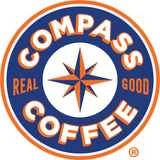We hope our actions inspire others to be more environmentally aware and make similarly simple, Earth-friendly lifestyle choices.
Sustainability is at the core of every decision we make, and it has been since day one. We strive for environmental, social, and economic sustainability in everything we do.
Internally, we developed a mascot based off of our Simple Earth-friendly Actions and Lifestyles: the Sustainability Seal. We believe in focusing on the small steps, the discrete action and lifestyle decisions that are simple and Earth-friendly, because we believe this will lead to the most sustainable long-term outcome.
As a pillar of the Washington, DC, food scene, we hope our actions inspire others to be more environmentally aware and make similarly simple, Earth-friendly lifestyle choices.

A Simple Reminder
The Sustainability Seal is a reminder of our approach to sustainability at Compass. We believe in focusing on discrete action and lifestyle decisions that are simple and Earth-friendly, because we believe this will lead to the most
sustainable long-term outcome.
Loring Roasters
The roasters we use at Compass Coffee are some of the most environmentally-friendly roasters on the planet. By using recirculated air through the roasting process, the Loring S35 Kestrel that adorned the floor of our first cafe and roastery in the historic Shaw neighborhood of Washington, DC, reduced fuel consumption and greenhouse gas emissions by 80% as compared to other conventional roasters.
As the water molecules present in green coffee evaporate and as the sugars and proteins caramelize due to the intense heat of the roaster, CO2 and H2O are natural byproducts of the roasting process.
More roasting would definitely mean more carbon emission; therefore, as we move to a facility that allows us to exponentially increase coffee production and distribution, we need roasters that are up to the task and still align with our goal to be as sustainable as possible. When it came to choosing a roaster to take us into the next chapter of Compass Coffee, we went back to what we knew provided the quality and sustainability we were used to and expected (albeit in a much larger package) and outfitted our new roastery with a pair of Loring S70 Peregrine roasters.
If the S35 was a Tesla Model S, the S70 is a full on Rimac C_Two: a machine capable of mind-boggling performance with a very, very minimal footprint.
Modbar Espresso Units
The Modbar espresso machines in our cafes don’t just look great, eliminate the boundaries between barista and customer, and produce the tastiest espresso around. Using insulated boilers and other methods to maintain accurate and even temperature control, these stunning machines are able to use significantly less energy than standard counter-top espresso machines. The same can be said for the steam units and automatic pour-over machines.
Reusable and Recyclable Packaging
The decision for sustainable packaging was one of the earliest decisions we made as a company. Though bags are the industry standard for retail coffee, they’re typically not recyclable. For people who go through multiple pounds of coffee a month, that means a lot of packaging waste! Not to mention, bags are far from puncture- and tear-proof so shipping, stocking, or customer error not only means a wasted package, but also could mean wasted coffee.
Though most people don’t know that they can bring them back for a refill at a discount, our tins and growlers are designed to be refillable.







